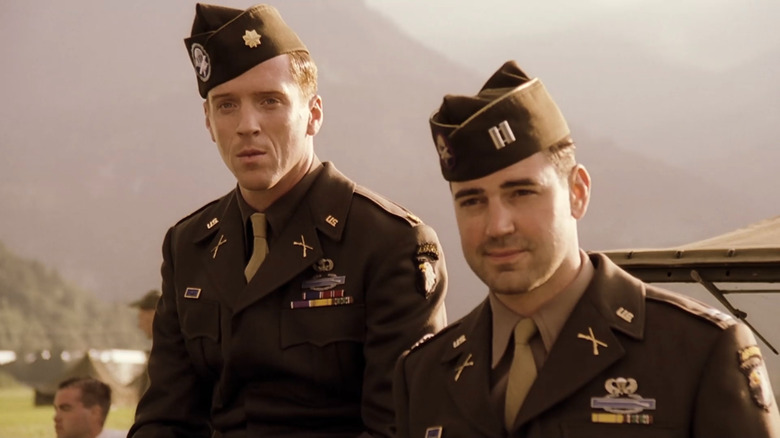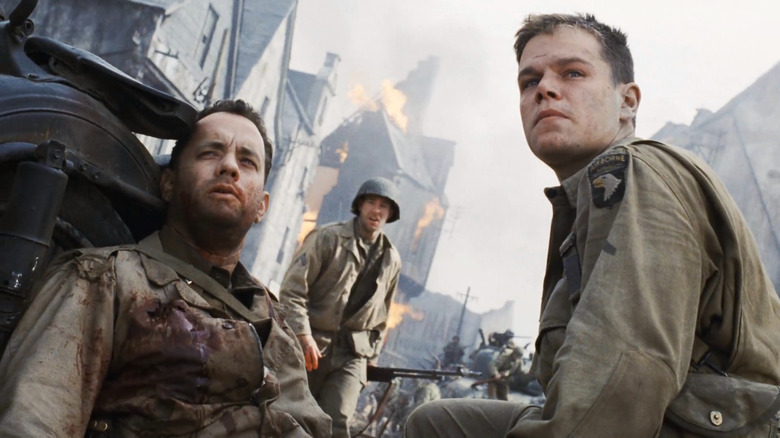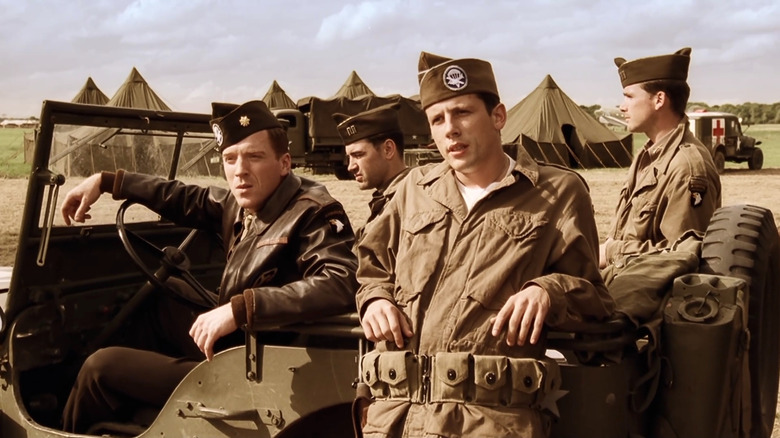Band Of Brothers Was 'Five Times Bigger' Than The Production Of Saving Private Ryan
The Oscar-winning "Saving Private Ryan" and Emmy-winning "Band of Brothers" have more in common than just the involvement of Steven Spielberg and Tom Hanks. "Band of Brothers" was based on the nonfiction book of the same name by Stephen E. Ambrose, who worked as a historical consultant on "Saving Private Ryan" and helped inspire its narrative. Ambrose's "D-Day June 6, 1944: The Climactic Battle of World War II" informed the visceral D-Day sequence in "Saving Private Ryan," while his "Band of Brothers" book provided a loose sketch of the titular Private Ryan (Matt Damon), in the form of U.S. soldier Fritz Niland, the only one of four real-life brothers who was believed to be alive before he was recalled home during the war.
For its part, HBO's 10-hour "Band of Brothers" miniseries was told on a much larger scale than "Saving Private Ryan," which clocked in just shy of three hours. According to the 2001 documentary "The Making of Band of Brothers," the series employed over 10,000 extras and 500 speaking roles, and it took three years to complete. It also carried a $125 million price tag, making it the most expensive TV miniseries ever produced at that point.
Whereas "Saving Private Ryan" centered largely on a detachment of eight soldiers, led by Hanks' Captain Miller, "Band of Brothers" put a whole company, nicknamed "Easy" Company, in focus, tracking their combat experiences from the invasion of Normandy to the Battle of the Bulge. In the documentary, Hanks said of Ambrose's book:
"It followed one group of guys, from literally their signing up for training, to the end of the European war. Jumped into Normandy on D-Day, and fought in Holland during Market Garden and then were in the Battle of the Bulge. Very well-chronicled, all the way through."
Spielberg's career-long fascination with World War II
Before they reteamed for "Band of Brothers," it was Tom Hanks who first passed the script for "Saving Private Ryan" off to Steven Spielberg.
In Spielberg's most recent film, the sorely overlooked coming-of-age drama, "The Fabelmans," the director's fictional, teenage alter ego, Sammy Fabelman, can be seen making a World War II movie with his fellow Eagle Scouts. When Spielberg, the Oscar-winning filmmaker, got involved in "Saving Private Ryan" in his 50s, he had already grappled with the Holocaust in "Schindler's List," after his earlier attempt at a World War II comedy, "1941," earned him some of the worst reviews of his career. To this day, "1941" is second only to "Hook" as his lowest-rated film on Rotten Tomatoes. However, it came almost two decades before "Saving Private Ryan," and if nothing else, it's a link in a chain.
In a 20th-anniversary retrospective of "Saving Private Ryan" in 2018, Spielberg told Chicago Tribune that his recurring interest in the war — which would lead him to "The Pacific" after "Band of Brothers" — began when he was young, as seen in "The Fabelmans." The preoccupation with this subject, he said, arose out of family conversations:
"Growing up, it was the seminal conversation inside my family. My parents talked about the Holocaust and they talked about World War II. And I was born knowing this. My dad was a veteran — he's still with us, thank God, 101 years old — he was in the Army Air Corps from 1942 to the beginning of 1945. He had many veterans over to the house, and I became absolutely obsessed with the Second World War, based on my father's stories, recollections and also based on all the World War II movies that eventually began playing on American television."
'The next generation of everything'
It's fitting, given his exposure to war movies on television, that Steven Spielberg would bring "Band of Brothers" to HBO. He served as co-creator and co-executive producer, lending the series his name recognition, though Tom Hanks first developed it with showrunner Erik Jendresen. Most of "Band of Brothers" was shot at Hatfield Aerodrome, which the making-of documentary describes as "a 1,100-acre back lot" in England. It was once an airfield, but for "Band of Brothers," it was "continually modified to portray 11 different European locations."
According to Movie-Locations.com, the village set was the same one built for "Saving Private Ryan," where it was used to depict the French town of Ramelle, the setting of the climactic "Alamo" bridge battle. The difference here was that "Band of Brothers" was using more of the surrounding acreage. As Hanks explained in the documentary, this enabled the production to appear as though it were location-hopping, even though much of it was shot in the same place:
"It's about five times bigger than what we had on 'Saving Private Ryan.' We're in Albourne and Upottery in England. We're in France, Normandy, Holland. We're in Bastogne. We're all over the place here. [...] It's a first-rate production facility for recreating the past, as well as sort of the next generation of everything, the next generation of special effects, the next generation of computer-generated effects."
Making use of thousands of American and German period costumes, "Band of Brothers" came just two years after "The Sopranos" premiered on HBO. It's an early example of the prestige miniseries, one that lobbied talent and resources from the movies to help usher in a new Golden Age of TV, which continues to this day.


